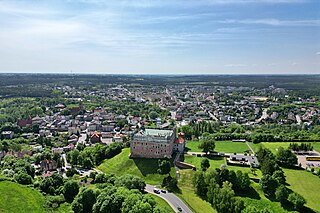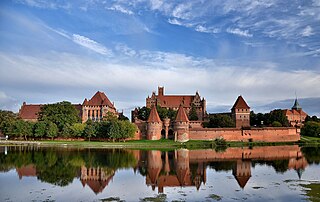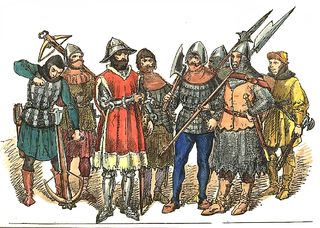
The Battle of Świecino also called the Battle of Żarnowiec or in German Die Schlacht bei Schwetz, took place on September 17, 1462, during the Thirteen Years' War. The Polish forces, commanded by Piotr Dunin and consisting of some 2,000 mercenaries and Poles, decisively defeated the 2,700-man army of the Teutonic Knights, commanded by Fritz Raweneck and Commander of the Order Kaspar Nostitz (Nostyc). Auxiliary forces sent by Duke Eric II of Pomerania, temporary ally of the Teutonic Knights, did not enter the battle.

The Teutonic Order is a Catholic religious institution founded as a military society c. 1190 in Acre, Kingdom of Jerusalem. The Order of Brothers of the German House of Saint Mary in Jerusalem was formed to aid Christians on their pilgrimages to the Holy Land and to establish hospitals. Its members have commonly been known as the Teutonic Knights, having historically served as a crusading military order for supporting Catholic rule in the Holy Land and the Northern Crusades during the Middle Ages, as well as supplying military protection for Catholics in Eastern Europe.

Malbork is a town in the Pomeranian Voivodeship, Poland. It is the seat of Malbork County and has a population of 37,898 people as of 2021. The town is located on the Nogat river, in the historical region of Pomerelia.
Mestwin II was a Duke of Pomerelia, member of the Samborides dynasty. He ruled Pomerelia as a sole ruler from 1273 to 1294.

Vytautas, also known as Vytautas the Great, was a ruler of the Grand Duchy of Lithuania. He was also the prince of Grodno (1370–1382), prince of Lutsk (1387–1389), and the postulated king of the Hussites.

Golub-Dobrzyń is a town in north-central Poland, located on the Drwęca. It is the capital of Golub-Dobrzyń County in the Kuyavian-Pomeranian Voivodeship and has a population of 13,060.

The State of the Teutonic Order was a theocratic state located along the southeastern shore of the Baltic Sea in northern Europe. It was formed by the knights of the Teutonic Order during the early 13th century Northern Crusades in the region of Prussia. In 1237, the Livonian Brothers of the Sword merged with the Teutonic Order of Prussia and became known as its branch – the Livonian Order. At its greatest territorial extent during the early 15th century, the State encompassed Chełmno Land, Courland, Gotland, Livonia, Estonia, Neumark, Pomerelia, Prussia and Samogitia.

Ordensburg is a German term meaning a "castle of a (military) order". It is used specifically for the fortified structures built by crusading German military orders during the Middle Ages.

The Gothic architecture arrived in Poland in the first half of the 13th century with the arrival of the Dominican and Franciscan orders. The first elements of the new style are evident in the foundation of the Dominican Trinity church in Kraków (1226–1250), built by Bishop Iwo Odrowąż. Rebuilding of the Wrocław Cathedral, started in 1244, was another early manifestation of the Gothic style. The earliest building in Poland built entirely in the Gothic style is the chapel of St. Hedwig in Trzebnica (1268–1269), on the grounds of a Cistercian monastery.

Gniew is a historic town situated on the left bank of the Vistula River, in the Pomeranian Voivodeship, in northern Poland. It has 6,870 inhabitants (2016). It is one of the oldest towns in Eastern Pomerania, and is renowned for its medieval brick gothic Castle, which has become one of the region's most recognizable monuments.

Ryn is a town in northeastern Poland located 19 km (12 mi) southwest of Giżycko, in the Warmian-Masurian Voivodeship, in Masuria. Until the reorganization of 1999 it had been assigned to Suwałki Voivodeship. It had a population of 3,062 inhabitants as of December 31, 2004.

Ludwig von Erlichshausen (1410–1467) was the 31st Grand Master of the Teutonic Knights, serving from 1449/1450 to 1467.

The Castle of the Teutonic Order in Malbork, commonly known as Malbork Castle, is a brick gothic castle complex located in the town of Malbork, Poland, built in 13th and significantly expanded in 14th century. It is the largest castle in the world measured by land area and a UNESCO World Heritage Site.

Polish–Teutonic Wars refer to a series of conflicts that took place between the Kingdom of Poland and the Teutonic Order, a medieval German military order with roots in the Baltic region. These wars occurred primarily during the 14th and 15th centuries and were characterized by territorial disputes, political maneuvering, and religious differences.

This is the 1308 Polish-Teutonic War. For a list of all Polish-German Wars, see Polish-German Wars.

Piaseczno is a village in the administrative district of Gmina Gniew, within Tczew County, Pomeranian Voivodeship, in northern Poland. It lies approximately 6 kilometres (4 mi) south-west of Gniew, 34 km (21 mi) south of Tczew, and 64 km (40 mi) south of the regional capital Gdańsk. It is located within the ethnocultural region of Kociewie in the historic region of Pomerania.

This is the 1454-1466 Polish-Teutonic War. For a list of all Polish-German Wars, see Polish-German Wars.
Conrad Letzkau was a councilman and later Mayor of Danzig who, together with Arnold Hecht, was assassinated by the Teutonic Knights.

Chełmno land is a part of the historical region of Pomerelia, located in central-northern Poland.

The Lidzbark Castle, officially known as Lidzbark Bishops' Castle, is a fortified castle and palace from the 14th century located in the town of Lidzbark Warmiński, Warmian-Masurian Voivodeship, in northern Poland. It is one of the most precious Gothic structures in the country and a popular destination for holidaymakers.



















